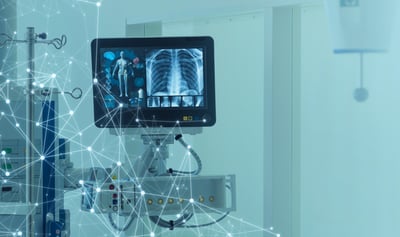Edge Computing, seen by many as the next revolution for processing data, extends network boundaries and takes computing power to where data is created, collated and acted on.
It delivers processing power to everyday objects and deep analytics capabilities to the core. Edge Computing will enable organisations of all sizes across every sector to develop new ways of working and innovative propositions that are more efficient while delivering better user experiences.
Ashminder Ubhi (Ash), CDW Category Lead for Core Data Centre and Pete Hulme, CDW Practice Lead for Hybrid Infrastructure, discuss four fundamental questions on how to get the most from Edge Computing.
 What Are the Opportunities of Edge Computing?
What Are the Opportunities of Edge Computing?
Pete: Edge Computing can help businesses perform local tasks more efficiently, make critical decisions rapidly and run analytics on devices right at the edge of their business, while also gathering large volumes of data into the core for deep analytics, trend analysis and predictive decision making. This enables a huge increase in velocity, service delivery and can fundamentally change how organisations operate their businesses.
Ash: Edge Computing is a completely new way to align the power of technology with the demands for new products and services. For example, consumers want faster speeds for better content-driven experiences while enterprises need local processing for more efficient operations.
Increased Computing Power
Another dimension to Edge Computing is its latent processing power. In a similar way to how people signed up to offer the unused processing power of their home computers for space research, smart devices can be harnessed too. For example, security cameras in stadiums that may only be needed for a few hours each week, could be providing additional previously untapped processing power. Edge Computing takes the possibilities to another level as there will be many more devices available with more computing power spread globally.
This additional computing power will open up opportunities that will improve service delivery and enable businesses to gain a competitive edge.
More Streamlined Patient Care Journeys in Healthcare
Ash: The ability to move processing power closer to where the data is created and consumed, whether by people or devices, has the potential to deliver critical information and knowledge to exactly where it is needed, when it is needed. For example, in healthcare – better informed, faster diagnosesPete: A typical ‘patient journey’ through healthcare may have many discrete steps – a GP visit, referrals to specialists, tests and x-rays. If data is collected and processed on devices closer to the patient at each step, then not only will there be better outcomes for patients but more efficient processes throughout the sector. Data can still be held centrally, facilitating in-depth analysis to show trends, for example, in population health, as well as to help with making forward planning decisions.


Reduction in Retail Fraud
Ash: Intelligent cameras positioned over self-checkout tills in supermarkets are helping to mitigate fraud. As part of an Edge Computing solution, these cameras can store a wealth of product information locally which can be compared in real-time against what a shopper is scanning. The days of someone saying they’ve bought an onion when really, they have an expensive avocado in their bag are numbered. On average, retailers are losing 1% of their revenue to this type of fraud so reducing this crime saves a significant amount of money.
Harness Third Party Data to Enhance Offerings
Ash: Another great example is harnessing real-time data from third parties to help make quicker decisions. For example, I worked with a customer to help them leverage real-time meteorological data for their local stores to finetune inventory based on micro-changes and outpace their regional competition. They were able to increase stocks of umbrellas, snow shovels, bottled water and ice cream based on local weather conditions, before their competition. This required a tight integration of real-time edge analytics in-store to support and data stored/processed at the core to support fast decision taking.
What’s the Best Way to Analyse and Map Your Data Landscape?
Pete: Keep an open mind and to talk to experts about the possibilities of Edge Computing. Then analyse your business to see where data, processing and analytics are best positioned.
Ash: Organisations should look at what is best done at the edge, what needs to come back to the core and what sits somewhere in between. In the case of a retailer that provides a shopping app for customers, the retailer needs to consider what is best offered via the app; what should be built into devices around the store; what processing could be done at an individual shop level; and what needs to come back to head office and the data centre for more complex, deeper analytics.
How Should You Address Issues Around Security and Data Privacy?
Ash: Security and data privacy are key concerns. Not only are legislative requirements increasing all the time, for example, GDPR, but with Edge Computing there are exponentially more devices, which mean an even larger attack surface. All data must be secure, wherever it is, both at rest and while in transit, which results in a much greater challenge if edge devices are not to comprise the entire corporate network.
Retrofit Security Costs More
Pete: With the traditional data centre, security was at the door, but once you entered it was relatively easy to access everything. Now everything could be ‘outside’ so organisations must think about securing each element. It can cost exponentially more to retrofit security than to build it in from inception by design, so the stakes are high, and good planning is paramount.
How Can You Successfully Navigate a Digital Transformation Journey?

Ash: Working with the right solution providers such as CDW provides easy access a well vetted and proven ecosystem of expert partners. We can help develop the right strategies and solutions for an organisation, bringing in the right integration of partners and technology to help achieve the required outcomes.
Pete: No one size fits all. It’s vital for organisations to choose the right partners to visualise, define and achieve goals in the best way. The right partners help to de-risk complex projects such as this whilst ensuring budgets and timelines are kept to.
Thank you for taking the time to read this blog, we hope that you found it useful. As a final note, if you are interested in understanding more about how Edge Computing technologies can help support your organisation, please feel free to contact us and one of our data centre experts will be more than happy to assist.


Ashminder Ubhi, CDW Category Lead - Core Data Centre & Pete Hulme, CDW Practice Lead for Hybrid Infrastructure.
For any enquiries contact: info@uk.cdw.com | 020 7791 6000
